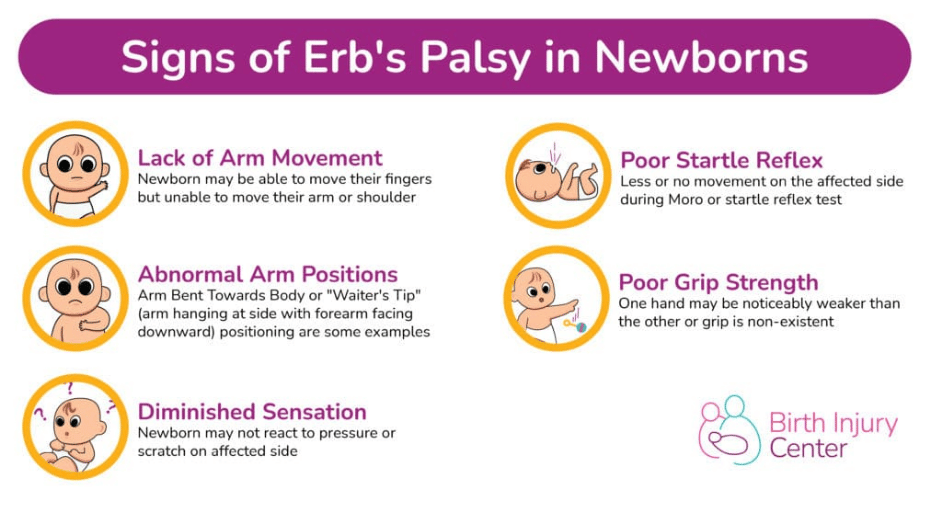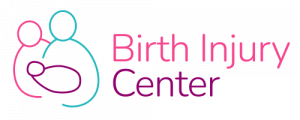Symptoms of Erb's Palsy
Erb’s palsy is a condition characterized by muscle weakness and loss of sensation in the arm. This condition can occur in both adults and infants and is related to an injury to the brachial plexus, which is a network of nerves located near the neck and shoulder. In infants, it may occur due to a birth injury if a traumatic force is exerted downward on a newborn’s upper arm and shoulder during the birthing process. This condition is estimated to occur at rates as high as 2.6 per 1000 births.
Home > Erb’s Palsy > Erb’s Palsy Symptoms
- Last Updated Date: September 22, 2023
Erb’s palsy is a condition characterized by muscle weakness and loss of sensation in the arm. This condition can occur in both adults and infants and is related to an injury to the brachial plexus, which is a network of nerves located near the neck and shoulder. In infants, it may occur due to a birth injury if a traumatic force is exerted downward on a newborn’s upper arm and shoulder during the birthing process. This condition is estimated to occur at rates as high as 2.6 per 1000 births.
Signs of Erb's Palsy in Newborns
The symptoms of Erb’s palsy in newborns can vary somewhat, depending on the specific injury and the extent of the nerve damage. Some of the more common symptoms of this condition can include the following.
Lack of Movement
When a child has Erb's palsy at birth, they may not be able to move their shoulder or arm but may be able to move their fingers. Additionally, this lack of movement can be mild or severe, ranging from a merely limited range of motion at the shoulder to no activity at all. Erb’s palsy involves damage to the upper nerves of the brachial plexus. If both the upper and the lower nerves of the brachial plexus are damaged, then this is a more severe condition known as total brachial plexus birth palsy, which leads to more severe symptoms.
Poor Reflexes
During the first three to four months of life, babies naturally have a reflex called the Moro reflex, also known as the startle reflex. When startled, the baby will splay out their arms, followed by bringing the arms in close to the body. In babies with Erb’s palsy, one of the arms will display less movement than the other one during the startle reflex.
Abnormal Arm Positions
Another common sign of this condition is an awkward positioning of the arm. The most common position is known as the “Waiter’s Tip” position. The arm hangs by the side of the body with the elbow extended, arm rotated towards the body, and the wrist and fingers bent. If you believe your child's arm position seems unnatural, it is essential to discuss the problem with your doctor.
Poor Grip Strength
Typically, if a child has suffered damage to their brachial plexus, it can also affect their ability to grip objects. Consequently, another sign of Erb's palsy is a grip in one hand that is noticeably weaker than the other or a non-existent grip.
Diminished Sensation
Loss of sensation is another sign of Erb’s palsy. Although a newborn can’t tell you what they’re feeling, babies with Erb’s palsy may react less to touches on one arm than on the other.

Causes of Erb's Palsy
Erb’s palsy can occur when a baby’s neck is stretched to the side, particularly when combined with a downward force on the shoulder. This is more likely during prolonged or difficult labor, and the actions of medical staff may increase the risk of injury.
Some factors that may increase the risk of Erb’s palsy include:

Poorly managed maternal diabetes or gestational diabetes:
This can lead to larger babies and more complex deliveries.

Breech birth:
This occurs when babies are born feet first. These babies have a slightly higher risk of developing this condition since their arms may be raised and more easily injured from the excess pressure.

Improper birthing techniques and tools:
This can cause the baby to be pulled out too quickly and forcibly from the birth canal, resulting in injuries to their shoulder and neck.

Size of the baby:
Large babies and petite mothers can make the delivery process more difficult.

Length of labor:
If it takes more than an hour between full dilation of the cervix and the delivery of the baby, there is a greater risk of Erb’s palsy and other brachial plexus injuries.
My Child Has Been Diagnosed With Erb's Palsy; Now What?
Generally, a doctor or pediatrician will be the one to diagnose Erb’s palsy based on the weakness of the child’s arms and a physical examination. The doctor can also order an ultrasound, x-rays, or other imaging tests to assess for damage to the bones and joints of the neck or the shoulder. In addition, the doctor can determine if any nerve signals are present in the muscle of the upper arms, with tests such as a nerve conduction study (NCS) or electromyography (EMG). A nerve injury can ultimately affect the development and growth of the child’s shoulder.
While this condition tends to remit with time, 10% of children diagnosed with Erb’s palsy will continue to suffer from its symptoms. Parents must monitor their children and have them quickly treated once these signs become apparent, to ensure their child receives proper care.
However, if you are looking for further support as a parent or a caregiver to someone with Erb’s palsy, numerous national organizations can provide you with help. For instance, the United Brachial Plexus Network and Mothers United for Moral Support can provide families the emotional aid and hope needed to get through this devastating time. The real world information offered in these groups can help parents find additional resources regarding treatment plans and other available options.
Treatment Options for Erb's Palsy
Treatment for Erb’s palsy includes many different procedures. The severity of the case of Erb’s palsy will inform the type and duration of treatment.
In some cases, non-surgical recovery such as daily physical therapy may be one of Erb’s palsy’s most effective treatment plans. During this treatment, the physical therapist or the physician will show you which motion exercises can help to promote your child’s healing and prevent joint stiffness in the shoulders, wrists, hands, and elbows.
The physical therapist can provide exercises and routines to follow and repeat at home to enhance recovery and increase range of motion.
If there isn’t significant improvement in the condition within three to six months, then surgery may be recommended to help restore nerve function in the arm. Options may include:
A nerve graft, in which a piece of a nerve is taken from a different part of the body and spliced into the arm
A nerve transfer procedure, in which a nerve from a different muscle is redirected to restore function in important muscles of the arm
Nerves heal slowly, so after surgery, it can take months or even years to see the full effects of the procedure. Rehabilitation exercises are important to help restore as much function as possible to the arm.
In addition, doctors can also use several other surgical options to treat this condition, such as:
- A release of joint contractures: A surgeon can release thickened soft tissues around the shoulder and elbow joints to allow more motion.
- A tendon transfer procedure: To improve the ability of the child to perform important functions like raising the arm, a piece of a functioning muscle along with its tendon may be moved from its original location into the shoulder area.
Even after completing these medical treatments, some children may continue to experience some weakness in their arms. They may also require further surgical procedures as they get older to help improve their functions. Regardless of the treatment plans, many children will need to be routinely examined by their doctor and may require specific recommendations based on their situation.
If your child suffers from Erb’s palsy, you may incur significant expenses related to your child’s treatment. For instance:
- Initial surgeries: Many of the initial surgeries for Erb’s palsy can cost families thousands of dollars.
- Continuing medical expenses: Even after the surgeries are complete, these children will need to follow up with physical and occupational therapists and may require prescription medications to help them with their pain and recovery.
- Loss of wages: Parents of a child with Erb’s palsy will often have to miss work to take care of their child and ensure they receive the needed treatment. Consequently, lost income is usually a direct result of living with this condition.
- Therapy: Living with Erb’s palsy is not easy, not only on the child but the whole family. Many families often seek therapy to handle this diagnosis and the effects of the condition.
Legal Options For Parents & Caregivers of Children with Erb's Palsy
If you believe your child’s Erb’s palsy was caused by another person’s wrongful, negligent, or reckless actions, then it is time to get the legal help they need. Both the stress and financial costs of the condition can take its toll, especially for your child’s future. With dedicated representation at your side, you can fight to have the negligent party take responsibility and pay compensation to you and your family.
Do not wait any longer to secure legal help. Contact a birth injury lawyer to review your case today, as you may be entitled to compensation to cover the costs of therapy and your child’s long-term care.
Written by:
Birth Injury Center Team
The Birth Injury Center aims to create informational web content and guides to help women and their families seeking support and guidance for birth injuries caused by medical negligence. All of the content published across The Birth Injury Center website has been thoroughly investigated and approved by medical expert Natalie Speer, RNC-OB.

